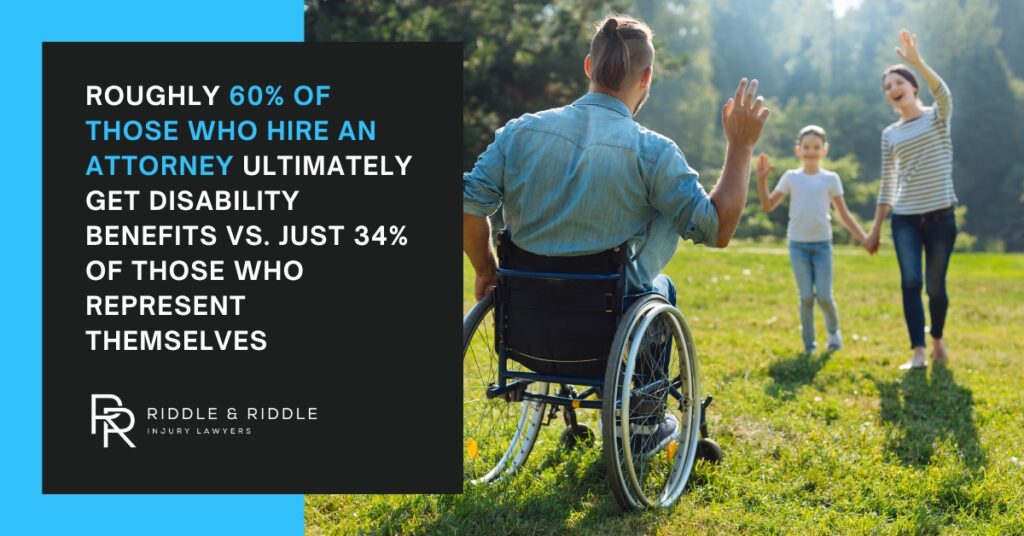Riddle & Riddle Injury Lawyers | February 18, 2020 | Social Security Disability

So, you’ve been seriously injured or developed a chronic disease or medical condition, and you cannot work. Now you’ve filed an application for Social Security Disability, and you’re wondering, what are the chances that I will win my case and be awarded Social Security Disability benefits?
What are the chances of winning a Social Security Disability appeal?

This post talks ONLY about your statistical odds of receiving benefits.
By way of background, the SSA reports that 591,687 individuals were awarded disability benefits in 2023.
Claims for Social Security disability can be made under two provisions of the law:
- Social Security Disability Income or “SSDI” claims are made by people who have worked and paid into the system for a long enough time period to qualify for benefits based on how much they paid in.
- Supplemental Security Income or “SSI” claims are made by people who have not worked and paid into the system, but who are without any significant assets or income so that they qualify. The benefit level for SSI recipients is usually lower than that for SSDI recipients.
In other words, 2 million Americans made claims for disability benefits in a year.
So, of those 2 million claims, what are the odds that each of them will eventually be approved?
Chances of Social Security Disability Approval at the “Initial Application” Level
At the first (called “Initial Application”) level, only about 30 percent of all claims are approved.
Those that are approved are usually for claimants who meet a “Listing” (check out the SSA’s “Listing of Impairments”) or who are so clearly and obviously disabled (for instance, those in a coma or rendered quadriplegics from accidents) that there is no question they cannot work.
This leaves roughly 70 percent of the original 2 million (or about 1.4 million) claims rejected at the Initial Application level.
Chances of Social Security Disability Approval at the “Reconsideration” Level
The next step in the SSA’s process is called “Reconsideration.”
At this step, a different Claim Examiner at the state’s Disability Determination Services (“DDS”) office reviews the work of the Examiner who reviewed the case at the Initial Application stage to see if anything was missed or of if the decision should be changed for other reasons.
On average, the chance of approval at the Reconsideration level is only 13 percent.
This means that only in 13 percent of the cases that are originally denied, DDS reverses the denial into an approval. The rest are denied a second time.
It is very frustrating for claimants at the Reconsideration stage because they have very little control over the time it takes to get through this stage (generally several months) or the result. Other than attending any doctor examinations or other appointments the SSA asks you to attend and making sure DDS has all your medical records, the Reconsideration stage simply involves waiting.
Chances of Social Security Disability Approval at the “Hearing” Level
If your case is denied at the Reconsideration level, the next step is to request a hearing before an Administrative Law Judge (“ALJ”). At this level (known as the “Hearing Level”), the odds of success go up significantly.
Nationally, about 47 percent of all cases at the Hearing Level are won by claimants.
Bear in mind, this percentage is for ALL claimants, whether or not they were represented by a lawyer at the Hearing Level. Studies have shown that claimants who are represented by a lawyer at this level have a better statistical chance of receiving benefits.
>>DID YOU KNOW? In fact, research shows that only 34 percent of those who do not hire an attorney are ultimately approved for disability benefits, but 60 percent of those who do hire an attorney are ultimately approved.
This leaves over half of the claimants who asked for a hearing before an ALJ without benefits.
Chances of Social Security Disability Approval at the “Appeals Council” Level
Some of these claimants believe the ALJ did not decide their case properly or fairly. Many of them appeal their ALJ denial up to the next level – the Appeals Council.
This Council is comprised of a number of Administrative Appeals Judges (“AAJ”) and staff whose job it is to review decisions of the ALJ’s to see if any mistakes were made. However, the odds that they will do that are low. Even though the Appeals Council has the power to reverse a denial by an ALJ, they rarely do this (statistically, only about 1 percent of the time).
However, the Appeals Council also has the power to send a case back to the ALJ who decided it to correct any errors they might believe were made. The Appeals Council does this about 9 percent of the time.
So, essentially 90 percent of the time, the Appeals Council approves the ALJ’s denial of benefits.
Chance of Social Security Disability Approval in Federal Court
If a claim falls into that 90% of cases reviewed but denied by the Appeals Council, the next step in the process is to file a lawsuit in the United States District Court (“Federal Court”) for your geographical area.
Here again, the Federal Court judge can either approve the ALJ’s denial, reverse the ALJ’s denial and award benefits, or remand the case back to the ALJ to fix any errors the Federal Court judge finds were made by the ALJ.
The Federal Court only reverses ALJ decisions and grants benefits about 2 percent of the time.
However, just under half of the time they find errors in the ALJ’s decision and remand it back to the ALJ to correct errors. So, your odds of success in Federal Court are significantly better than they are at the Appeals Council level.
Finally, three other factors relating to your odds of success:
- Claimants facing urgent financial emergencies (eviction, utility service cut-off, or inability to afford life-saving medical procedures) can be placed in what the SSA calls “dire need” status and have their hearings expedited and heard more quickly. However, the criteria to prove “dire need” is quite stringent because there are already so many people waiting for hearing dates.
- Certain medical conditions are considered so severe that they qualify for payment under the SSA’s “compassionate allowance” rules, allowing the claimant to be approved for benefits without a hearing if the medical records are overwhelming and strong.
- Some older claimants with very strong cases can request approval of their claims “on the record,” meaning based simply on the strength of their medical records without the need for a hearing. The granting of on-the-record approvals has decreased over the years as the SSA has become more stringent in the number of claims they pay.
These are just three more reasons you should hire an experienced Social Security Disability attorney to help you with your claim for benefits.
We know when and how to ask for these special requests.
So, to recap:
- Around 2 million disabled worker claims for disability benefits are filed each year with the Social Security Administration;
- About 70% of those claims are denied at the Initial Application level;
- Of that 70%, only about 13% are approved at the Reconsideration level;
- Of the remainder, about 47% are approved at the ALJ Hearing level;
- Of the 53% of those cases that are NOT approved at the ALJ Hearing level and then appealed to the Appeals Council, 90% of the time the Appeals Council agrees with the ALJ’s denial of benefits.
- Of those cases denied by the Appeals Council and then filed in Federal Court, just under half are either reversed (and benefits paid) or remanded to the ALJ level for further action.
Looking for a North Carolina disability lawyer?

The disability team at Riddle & Riddle is led by a Board-Certified Specialist in Social Security Disability law, with more than three decades of experience fighting for North Carolinians with disabilities.
We believe Justice Counts and would love to help you if we can.
There are no upfront costs and no attorney fees unless we win your claim or appeal and you receive disability benefits.
The consultation is free and there is no obligation. We only get paid if we win your case and you receive the benefits you need and deserve.
Justice Counts.
Contact a Personal Injury Lawyer from Riddle & Riddle Injury Lawyers for Help Today
For more information, please contact Riddle & Riddle Injury Lawyers to schedule a free consultation with a personal injury lawyer in North Carolina today. We have twelve convenient locations in North Carolina, including Greenville, Raleigh, Goldsboro, Jacksonville, Kinston, Charlotte, Greensboro, Durham, Fayetteville, Wilmington, Winston-Salem & Garner.
Riddle & Riddle Injury Lawyers – Raleigh Office 4600 Marriott Dr STE 500, Raleigh, NC 27612 (919) 876-3020
Riddle & Riddle Injury Lawyers – Charlotte Office 1914 J N Pease Pl Suite 142, Charlotte, NC 28262 (704) 486-5824
Riddle & Riddle Injury Lawyers – Durham Office 100 E Parrish St STE 200, Durham, NC 27701 (919) 728-1770
Riddle & Riddle Injury Lawyers – Garner Office 500 Benson Rd Suite 111, Garner, NC 27529 (800) 525-7111
Riddle & Riddle Injury Lawyers – Greensboro Office 7B Corporate Center Ct Suite 15, Greensboro, NC 27408 (336) 516-9066
Riddle & Riddle Injury Lawyers – Greenville Office 300 E Arlington Blvd Suite 2A #110, Greenville, NC 27858 (252) 397-8620
Riddle & Riddle Injury Lawyers – Goldsboro Office 601 N Spence Ave, Goldsboro, NC 27534 (919) 778-9700
Riddle & Riddle Injury Lawyers – Jacksonville Office 3391 Henderson Dr, Jacksonville, NC 28546 (910) 455-5599
Riddle & Riddle Injury Lawyers – Kinston Office 807 N Queen St, Kinston, NC 28501 (252) 397-8624
Riddle & Riddle Injury Lawyers – Fayetteville Office 2517 Raeford Rd, Fayetteville, NC 28305 (910) 387-9186
Riddle & Riddle Injury Lawyers – Wilmington Office 1608 Queen St Suite 12, Wilmington, NC 28401 (910) 889-4064
Riddle & Riddle Injury Lawyers – Winston-Salem Office 102 W 3rd St, Ste 1007, Winston-Salem, NC 27101 (336) 516-9042
